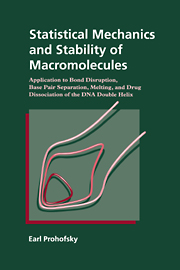 Statistical Mechanics and Stability of Macromolecules
Statistical Mechanics and Stability of Macromolecules Published online by Cambridge University Press: 16 September 2009
Greater helix
The study of the dynamics of a helix with elements, such as a drug, attached to it is easiest when there is an excess of the element so that it forms a repeating pattern of attachment. This allows the use of lattice methods to solve the large dimensional problem associated with the long helix. When only one element (or a few elements) attaches to a long helix the study is best handled by methods developed in Chapters 11 and 13. One of the more extensively studied attaching drugs is daunomycin, probably because it is an important antitumor agent. It is one of a number of drugs that intercalate into the helix, i.e. part of it has a planar structure that enters between base pairs of the helix. The specific example studied is the repeating unit of daunomycin–poly(GCAT)–poly(ATGC) (Chen and Prohofsky, 1994). The calculation determines the probability of the drug dissociating from the DNA helix which can be converted to give the binding constant of the drug to the helix. The choice of the particular DNA sequence was dictated by the availability of X-ray conformational information (Wang et al., 1987). The helix is somewhat distorted by the intercalation and the calculation uses the distorted conformation and the correct daunomycin position. The bases are numbered in the unit cell by calling the first guanine G1 then proceeding down one strand in the 3′ to 5′ direction so that the next cytosine is C2, then comes A3 and T4.
To save this book to your Kindle, first ensure [email protected] is added to your Approved Personal Document E-mail List under your Personal Document Settings on the Manage Your Content and Devices page of your Amazon account. Then enter the ‘name’ part of your Kindle email address below. Find out more about saving to your Kindle.
Note you can select to save to either the @free.kindle.com or @kindle.com variations. ‘@free.kindle.com’ emails are free but can only be saved to your device when it is connected to wi-fi. ‘@kindle.com’ emails can be delivered even when you are not connected to wi-fi, but note that service fees apply.
Find out more about the Kindle Personal Document Service.
To save content items to your account, please confirm that you agree to abide by our usage policies. If this is the first time you use this feature, you will be asked to authorise Cambridge Core to connect with your account. Find out more about saving content to Dropbox.
To save content items to your account, please confirm that you agree to abide by our usage policies. If this is the first time you use this feature, you will be asked to authorise Cambridge Core to connect with your account. Find out more about saving content to Google Drive.